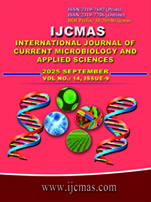


 National Academy of Agricultural Sciences (NAAS)
National Academy of Agricultural Sciences (NAAS)

|
PRINT ISSN : 2319-7692
Online ISSN : 2319-7706 Issues : 12 per year Publisher : Excellent Publishers Email : editorijcmas@gmail.com / submit@ijcmas.com Editor-in-chief: Dr.M.Prakash Index Copernicus ICV 2018: 95.39 NAAS RATING 2020: 5.38 |
Catheter-related bloodstream infections (CRBSIs) are a major cause of morbidity in patients with chronic kidney disease (CKD) undergoing maintenance hemodialysis. We report the case of a 19-year-old female with bilateral grade IV CKD and end-stage renal disease (ESRD) on hemodialysis via a right internal jugular vein (IJV) catheter, who presented with fever, nausea, and vomiting. Blood cultures obtained from the central line and peripheral vein flagged positive with a 2.5-hour differential time to positivity. Gram staining and culture revealed Gram-negative bacilli, later identified by MALDI-TOF MS as Rhizobium radiobacter, an emerging opportunistic pathogen. Antimicrobial susceptibility testing demonstrated susceptibility to cotrimoxazole, fluoroquinolones, cefepime, meropenem, and minocycline, but resistance to ceftazidime and amikacin. The patient was treated with cefoperazone-sulbactam and catheter removal, following which repeat blood cultures were sterile. R. radiobacter, once considered a contaminant, is increasingly recognized as a true pathogen in immunocompromised hosts with indwelling intravascular devices due to its ability to adhere to silicone surfaces. This case highlights the importance of considering R. radiobacter as a potential cause of CRBSI in hemodialysis patients and emphasizes prompt diagnosis, appropriate antibiotic therapy, and catheter removal as critical components of management.
Chen CY, Hansen KS, Hansen LK. Rhizobium radiobacter as an opportunistic pathogen in central venous catheter-associated bloodstream infection: case report and review. J Hosp Infect. 2008 Mar;68(3):203–7. https://doi.org/10.1016/j.jhin.2007.11.021
Egemen O, Ozkaya O, Bingol D, Akan M. Rhizobium radiobacter: An unusual pathogen isolated on an active chronic ulcerous inflammation.
Guo H, Zhang L, He H, Wang L. Risk factors for catheter-associated bloodstream infection in hemodialysis patients: A meta-analysis. PLOS ONE. 2024 Mar 27;19(3):e0299715. https://doi.org/10.1371/journal.pone.0299715
Halas R, Jacob C, Badwal K, Mir R. Rare case of Rhizobium radiobacter bioprosthetic mitral valve endocarditis. IDCases. 2017 Sep 20;10:88–90. https://doi.org/10.1016/j.idcr.2017.08.008
Lai CC, Teng LJ, Hsueh PR, Yuan A, Tsai KC, Tang JL, et al., Clinical and Microbiological Characteristics of Rhizobium radiobacter Infections. Clinical Infectious Diseases. 2004 Jan 1;38(1):149–53. https://doi.org/10.1086/380463
Mastroianni A, Coronado O, Nanetti A, Manfredi R, Chiodo F. Agrobacterium radiobacter pneumonia in a patient with HIV infection. Eur J Clin Microbiol Infect Dis. 1996 Dec;15(12):960–3.
Mermel LA, Farr BM, Sherertz RJ, Raad II, O’Grady N, Harris JS, et al., Guidelines for the management of intravascular catheter-related infections. Clin Infect Dis. 2001 May 1;32(9):1249–72. https://doi.org/10.1086/320001
Paphitou NI, Rolston KVI. Catheter-related bacteremia caused by Agrobacterium radiobacter in a cancer patient: case report and literature review. Infection. 2003 Dec;31(6):421–4. https://doi.org/10.1007/s15010-003-3175-5
Ponnapula S, Swanson JM, Wood GC, Boucher BA, Wells DL, Croce MA, et al., Treatment of Rhizobium radiobacter Bacteremia in a Critically Ill Trauma Patient. Ann Pharmacother. 2013 Nov 1;47(11):1584–7. https://doi.org/10.1177/1060028013500942
Tiwari S, Beriha SS. Primary Bacteremia Caused by Rhizobium radiobacter in Neonate: A Rare Case Report. J Clin Diagn Res. 2015 Oct;9(10):DD01–2. https://doi.org/10.7860/jcdr/2015/15101.6598 |
 |
 |
 |
 |